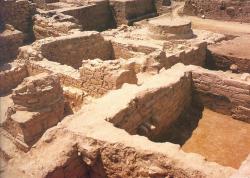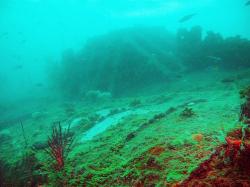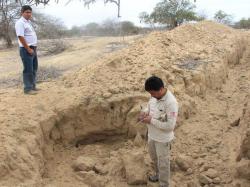INSTITUT SUPERIEUR D'ANTHROPOLOGIE
INSTITUTE OF ANTHROPOLOGY
ONLINE COURSES / COURS A DISTANCE
WINTER TERM : JANUARY 2014
REGISTER NOW
PAKISTAN –  Pashkalavati - The first phase of excavation at the 2,000-year-old city of Pashkalavati, near Charsadda, about 25 miles from here, has been completed jointly by the Peshawar University Archaeology Department and the Cambridge University archaeological mission under the supervision of Dr Ahmad Hassan Dani and Dr Alchin. The remains of the original city have been found.They said the first phase of excavation, which is almost complete, included the uncovering of one block of house of the Kushan period. The second phase would include tracing out the whole city to uncover the Scythian period and in the third phase the Greek period. In the remaining two years, other aspects of the old city would be traced and research done on the findings. They disclosed that as a result of the excavation, which the two universities jointly started, the original city of Pashkalavati which flourished between the second century B.C. and the third century A.D. had been discovered. From the burnt wood they discovered during the excavation, it became known that the city was burnt and destroyed in the third century A.D. The city discovered, they said, was well-planned with streets laid down on a pattern which showed its Greek origin. Streets and a block of several houses have been discovered. The structure of the houses, they said, shows three main types corresponding with phases so far uncovered. In the uppermost level, the houses were built of pressed mud with pebbles, very much like the houses found presently in nearby villages. Under these houses were found stone walls of masonry typical of Kushan period. At a still lower level, an extensive series of mud-brick walls were found. Nearly 200 copper coins have been found from the top-most level belonging to Kanishka and his successors dating to the second century A.D. The middle strata belong to the early Kushan period and the lower strata to the Scytho-Parthian period dating to the first century B.C.
Pashkalavati - The first phase of excavation at the 2,000-year-old city of Pashkalavati, near Charsadda, about 25 miles from here, has been completed jointly by the Peshawar University Archaeology Department and the Cambridge University archaeological mission under the supervision of Dr Ahmad Hassan Dani and Dr Alchin. The remains of the original city have been found.They said the first phase of excavation, which is almost complete, included the uncovering of one block of house of the Kushan period. The second phase would include tracing out the whole city to uncover the Scythian period and in the third phase the Greek period. In the remaining two years, other aspects of the old city would be traced and research done on the findings. They disclosed that as a result of the excavation, which the two universities jointly started, the original city of Pashkalavati which flourished between the second century B.C. and the third century A.D. had been discovered. From the burnt wood they discovered during the excavation, it became known that the city was burnt and destroyed in the third century A.D. The city discovered, they said, was well-planned with streets laid down on a pattern which showed its Greek origin. Streets and a block of several houses have been discovered. The structure of the houses, they said, shows three main types corresponding with phases so far uncovered. In the uppermost level, the houses were built of pressed mud with pebbles, very much like the houses found presently in nearby villages. Under these houses were found stone walls of masonry typical of Kushan period. At a still lower level, an extensive series of mud-brick walls were found. Nearly 200 copper coins have been found from the top-most level belonging to Kanishka and his successors dating to the second century A.D. The middle strata belong to the early Kushan period and the lower strata to the Scytho-Parthian period dating to the first century B.C.
http://dawn.com/news/1056890/ruins-of-2000-year-old-city-found-near-peshawar
PEROU –  Mocollope - Dig at the Mocollope archaeological complex began in early September. Now, excavators may be close to revealing their finds.Archaeologists have reportedly discovered human remains as well as metal and ceramic artifacts in a dig at the Mocollope archaeological complex in the district of Chocope in the region of La Libertad, in northern Peru. But that information didn’t come directly from the archaeologists working on the dig. Archaeologist Régulo Franco told La República only that “We are exploring the progress on the investigation and the conservation work. At this time, I can’t give any more information.” According to La República, Franco says that investigators are dealing with artifacts from the Moche civilization, from approximately 200 AD – 800 AD. But Carlos Alza Moncada, the mayor of Chocope, told press that archaeologists have discovered human skeletal remains, fragmented ceramic artifacts, and a metal mask. Alza also condemned the “huaqueros,” thieves that rob archaeological sites for pieces to sell on the antiquities black market. Shortly before the dig at Mocollope began, archaeologist Franco theorized that the complex may contain the tomb of an important Moche figure. Franco is famous in the archaeological world for his 2006 discovery of the tomb of the Lady of Cao.
Mocollope - Dig at the Mocollope archaeological complex began in early September. Now, excavators may be close to revealing their finds.Archaeologists have reportedly discovered human remains as well as metal and ceramic artifacts in a dig at the Mocollope archaeological complex in the district of Chocope in the region of La Libertad, in northern Peru. But that information didn’t come directly from the archaeologists working on the dig. Archaeologist Régulo Franco told La República only that “We are exploring the progress on the investigation and the conservation work. At this time, I can’t give any more information.” According to La República, Franco says that investigators are dealing with artifacts from the Moche civilization, from approximately 200 AD – 800 AD. But Carlos Alza Moncada, the mayor of Chocope, told press that archaeologists have discovered human skeletal remains, fragmented ceramic artifacts, and a metal mask. Alza also condemned the “huaqueros,” thieves that rob archaeological sites for pieces to sell on the antiquities black market. Shortly before the dig at Mocollope began, archaeologist Franco theorized that the complex may contain the tomb of an important Moche figure. Franco is famous in the archaeological world for his 2006 discovery of the tomb of the Lady of Cao.
http://www.peruthisweek.com/news-peru-archaeologists-tight-lipped-about-finds-at-mocollope-complex-101506
CANADA –  Muskrat Falls - Nalcor Energy says thousands of Innu artifacts, including food, tools and ceramics, have been recovered near the Muskrat Falls hydroelectric project and presented to Innu elders.Excavation began last year on the south side of the Churchill River in the area that will be developed for the project’s powerhouse and spillway. An archaeological team returned to the area this year for additional recovery work, including eight new sites on the North Spur. More than 40,000 artifacts were recovered from the site, described as ancient Amerindian campsites dating back to between 2,000 and 3,500 years ago. One of the sites involved the placement of large rocks, which one elder said was used as an area for building canoes. Recovery work is now complete for the year and materials will be handed over to the provincial archaeology office for further examination.
Muskrat Falls - Nalcor Energy says thousands of Innu artifacts, including food, tools and ceramics, have been recovered near the Muskrat Falls hydroelectric project and presented to Innu elders.Excavation began last year on the south side of the Churchill River in the area that will be developed for the project’s powerhouse and spillway. An archaeological team returned to the area this year for additional recovery work, including eight new sites on the North Spur. More than 40,000 artifacts were recovered from the site, described as ancient Amerindian campsites dating back to between 2,000 and 3,500 years ago. One of the sites involved the placement of large rocks, which one elder said was used as an area for building canoes. Recovery work is now complete for the year and materials will be handed over to the provincial archaeology office for further examination.
http://metronews.ca/news/canada/861403/artifacts-recovered-at-muskrat-falls/
ROYAUME UNI - Newark - Archaeologists have been searching underground in Newark in an attempt to discover more about the town's history.Trent and Peak Archaeology have conducted a ground-penetrating radar survey in the castle grounds. The technique sends high-frequency radio waves into the ground and receives reflected signals from buried materials or voids underneath, such as stone walls or tunnels. The castle survey therefore provided a unique opportunity to address unanswered questions about the building's history. It is thought the wall of the castle that survives today was rebuilt between 1275 and 1300, but very little is known about the castle's original form. Rene Mouraille, castle and parks ranger for Newark and Sherwood District Council, said: "This is an excellent opportunity to clarify where the original castle curtain wall, built by the Bishop of Lincoln, Alexander the Magnificent, is situated. "It is quite possible that the foundations of both the earlier west-facing curtain wall and perhaps several turrets may remain in reasonable condition buried somewhere under the castle terrace."
http://www.nottinghampost.com/High-tech-meets-old-world-Newark-underground/story-20110166-detail/story.html
USA - Salmon Ruins - Scientists have long understood pueblos in Chaco Canyon were aligned to the summer and winter solstices and other astronomical events. In the 1970s, when archaeologists excavated Salmon Ruins, just east of Farmington, they found a room they've since confirmed was a solar observatory. At one end of the rectangular room is a narrow window that apparently had an arch over it. The arch focused sunlight on the opposite wall where there was an altar. Scientists reconstructed the altar with a flat slab and two stone markers. On the summer solstice at noon, sunlight precisely highlights one of the rocks. Archaeologist Larry Baker, director of Salmon Ruins, says the feature on the replicated altar is lit up for three days before, on the solstice itself, and three days after. Then the wall blocks sunlight and the light on the altar disappears.
http://www.scsun-news.com/silver_city-entertainment/ci_24565806?source=rss
INDONESIE –  Java Sea - A group of Indonesian archeologists has discovered what is believed to be the wreck of a German U-boat that sank during World War II lying on the floor of the Java Sea about 100 kilometers from Karimunjawa Island.The team of 16 people has yet to find any physical evidence such as symbols on the hull of the submarine to confirm that it was a German vessel, but it has found plates with the Nazi swastika printed on them. “We found two plates inside the submarine. This finding strengthens our belief that it is one of the two German U-boats that sank in the Java Sea during World War II,” Shinatria told The Jakarta Post on Wednesday. According to website uboat.net, which gathers all information relating to the German U-boats of both world wars, two U-boats were sunk in the Java Sea during Word War II. The type IXC/40 submarine U-183 sank on April 23, 1945, after being hit by a torpedo from the US submarine, USS Besugo. The type IXC/40, U-168, sank on Oct. 6, 1944, after being hit by a torpedo fired by the Dutch submarine, HNLMS Zwaardvisch, the website says. “We suspect that the submarine we’ve found is the U-168, which was built in Germany in 1942,” Shinatria said, adding that 40 percent of the submarine’s hull was damaged. He said that the team also found skeletons, presumed to be of members of the U-boat’s crew, remains of a torpedo, a telescope, shoes and cups inside the submarine.
Java Sea - A group of Indonesian archeologists has discovered what is believed to be the wreck of a German U-boat that sank during World War II lying on the floor of the Java Sea about 100 kilometers from Karimunjawa Island.The team of 16 people has yet to find any physical evidence such as symbols on the hull of the submarine to confirm that it was a German vessel, but it has found plates with the Nazi swastika printed on them. “We found two plates inside the submarine. This finding strengthens our belief that it is one of the two German U-boats that sank in the Java Sea during World War II,” Shinatria told The Jakarta Post on Wednesday. According to website uboat.net, which gathers all information relating to the German U-boats of both world wars, two U-boats were sunk in the Java Sea during Word War II. The type IXC/40 submarine U-183 sank on April 23, 1945, after being hit by a torpedo from the US submarine, USS Besugo. The type IXC/40, U-168, sank on Oct. 6, 1944, after being hit by a torpedo fired by the Dutch submarine, HNLMS Zwaardvisch, the website says. “We suspect that the submarine we’ve found is the U-168, which was built in Germany in 1942,” Shinatria said, adding that 40 percent of the submarine’s hull was damaged. He said that the team also found skeletons, presumed to be of members of the U-boat’s crew, remains of a torpedo, a telescope, shoes and cups inside the submarine.
http://www.thejakartapost.com/news/2013/11/21/wreck-nazi-u-boat-submarine-located-java-sea.html
PEROU –  Ficuar - The town of Olmos in the northern region of Lambayeque in Peru is saddened and bewildered after large swaths of the local Ficuar archaeological complex were destroyed by unknown parties. Andina news agency reports that the site is 800 to 900 years old. Archaeologist Juan Ugáz Moro told Andina that the areas of the destroyed included platforms that may have been used as an administration area and patio. According to Andina, 5,000 square meters of the Ficuar complex were destroyed, representing about 60 percent of the site’s total area.
Ficuar - The town of Olmos in the northern region of Lambayeque in Peru is saddened and bewildered after large swaths of the local Ficuar archaeological complex were destroyed by unknown parties. Andina news agency reports that the site is 800 to 900 years old. Archaeologist Juan Ugáz Moro told Andina that the areas of the destroyed included platforms that may have been used as an administration area and patio. According to Andina, 5,000 square meters of the Ficuar complex were destroyed, representing about 60 percent of the site’s total area.
http://www.peruthisweek.com/news-ficuar-archaeological-complex-in-northern-peru-destroyed-lambayeque-101509